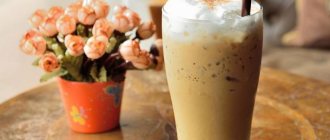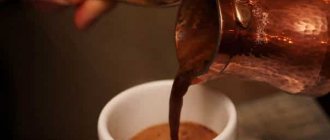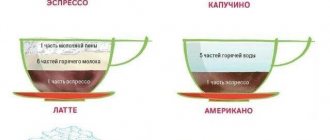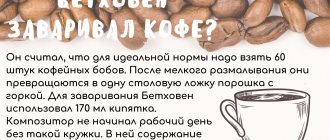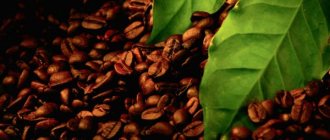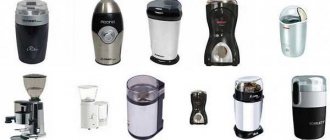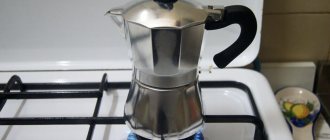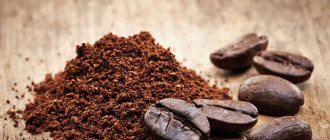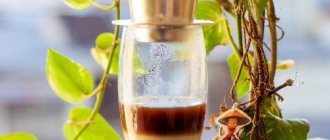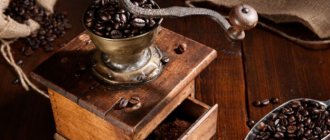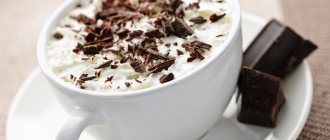In many cafes, when you order a cappuccino or latte, they will serve it with a beautiful design. If the barista is in a hurry, it can be a simple heart, or a so-called rosette (rosetta), or a leaf drawn with white milk on the brownish-golden surface of the coffee. If you have free time and inspiration, the drawing can be quite complex and unusual, voluminous. This is a separate type of coffee art, and many are interested in the name of coffee with a pattern on the foam.
Coffee with a design on the foam is called latte, and the process itself is called latte art. Although now they can draw something interesting on a cappuccino, originally it was just a latte, a coffee cocktail in a beautiful glass, and the baristas tried to somehow decorate it additionally.
There are different methods of application, including automatic ones, using a special printer, but the ability to create drawings in the latte art style manually is much more valued. Syrups, cocoa and grated chocolate can also be used. We tell you all about drawings on coffee.
A little history of latte art
Initially, painting on coffee began in Italy, but it was the Americans who made such coffee popular throughout the world. Already in the late 1980s, most coffee shops served their visitors cups with painted rosettes and leaves, and in the early 2000s they conquered the whole world, including Europe and the countries of the post-Soviet space.
Today, Asian baristas are considered the best masters in the world, whose art receives constant awards at championships, and it is Asians who surprise the whole world with the help of social networks.
There are more than three million photos on Instagram using the hashtag #latteart, and top videos on Youtube receive more than five million views.
A beautiful presentation of the drink is very important for popularizing establishments, as visitors like to post photos with beautiful cups of coffee. Therefore, many establishments spare no expense and time in training their employees, and professionally, craftsmen who can quickly and confidently create unusual, original drawings on coffee are highly valued.
I am my own artist and barista.
Surely, many are wondering how to make drawings on coffee, thinking about testing their own strength. If you just want to surprise your loved ones on the occasion of a special occasion, you can resort to using a coffee machine and stencils. The technique will help you prepare a latte with thick milk foam, and by sprinkling the stencil with cinnamon, cocoa or grated chocolate, you can get a dark pattern on the surface of the white foam. You can come up with and make templates yourself, or buy ready-made ones according to your taste. But if you want to reach certain heights in latte art, get ready for the fact that this is a rather complex science that requires knowledge of technology, equipment and long-term practical skills. Before you learn how to paint on coffee, you should learn the basics of materials science for sophisticated coffee painting:
- As a base, take a cup with a round bottom, filling it 1/3 with ready-made coffee;
- a “picturesque canvas” is placed on top in the form of thick milk foam with an ideal glossy surface, prepared in an espresso cooker with a powerful foaming agent;
- instead of a brush and pencil, they use a pitcher - a container for pouring milk, in other words, a ladle with straight walls and a spout, narrowed towards the bottom;
- additional drawing tools will be skewers and toothpicks, which are used to make small details on foamy milk.
Types of latte art designs
The most popular and famous drawings are, of course, the simplest. It is important to prepare the coffee correctly and froth the milk, and then practice pouring it with simple but precise movements. A blurry picture suggests that the barista often does not know how to prepare a good drink at all, since these are basic skills - well-frozen milk will form the right layers and streaks correctly.
Start learning with something simple:
- Heart. The most basic drawing, which is believed to be possible almost by accident, simply due to the characteristics of free pouring. First, milk is poured into the center of the cup from a greater distance so that it gets to the bottom, and when three-quarters of the foam has poured out, the pouring is slowed down, pouring the foam closer to the edges. Explaining the principle of infusion is more difficult than understanding it from simple training videos, of which there are so many on the Internet.
- Socket. Tilt the cup about 45 degrees and start pouring from a height so that the foam settles to the bottom, creating the base of the pattern. Next, bring the jug closer and slow down the pouring by rocking the pitcher jug from side to side. Don't rock the cup! We draw from the wide base to the thin upper leaves, then with a sharper movement we extend the stream to the base.
- Tulip. The principle is the same as in the rosette, the only difference is how exactly to draw the leaves and pour more foam into the upper area of the cup to create a flower head. We pour in portions, with each next speck, as if pushing away the previous one, which will spread.
- Twig. Pour foam into the bottom, we need a dense base on which the pattern will lie. Next, carefully pour in at least five milk dots/spots, each separately, and use a toothpick to draw a line through them. The drops will curl into mini hearts or leaves.
By and large, the twig belongs to the etching technique, but it is so simple that anyone can master it.
Etching technique for latte art
Above we looked at free pouring techniques, where the main principle is to simply pour in milk foam while rocking the pitcher. Etching is a more complex technique; the principle is to draw on the surface using toothpicks or special tools; here they paint with syrups.
- With a toothpick you can create the same heart or twigs from almost any stain, or transform it into a cute animal. We not only complete the lines, but by dipping a toothpick in the espresso, we can draw dark spots on the lighter foam. The main thing is to do this relatively quickly, and not to hesitate, since the bases, although viscous, are not too dense.
- With syrups, everything is also not so difficult. You can draw banal hearts or spirals, as well as intersecting lines, in the cup, but the eye is important to create smooth intersections of lines. The most commonly used are chocolate or caramel sauce, as they always go well with the coffee flavor.
Please note: to paint on coffee foam, you need special syrup-sauces, thicker and in soft bottles. The ones in glass bottles, used to produce dozens of flavors, are too liquid, they will simply fall into foam.
What types of glasses can be found on store shelves?
First, you need to decide how the hero of our article differs from other vessels: a wine glass, a shot glass, a glass and a shot. In a general sense, glasses are usually called any types of thin-walled containers for drinks, while, for example, a wine glass necessarily has a thin stem and preferably something containing alcohol is poured into it. Glass – designed for strong drinks, has a very small volume and a short stem. A shot glass is a small, usually one or two sips, glass without a stem, the contents of which have an increased number of degrees, and a shot is simply the English name for the same type of glass product.
There is an unwritten rule - the stronger the alcohol, the smaller the container it will be poured into. This is due to the fact that strong alcohol is usually drunk in one gulp while exhaling, and it is more convenient to do it this way. The exception is cognac, which is poured into special glasses (discussed below) in small portions and warmed in the hands, enjoying the play of light and the aroma of what is poured.
Drinkware is most often made from glass and crystal, which is the same glass, but with an admixture of lead. It is due to this admixture that we can observe the shine and play of light. In addition, lead contributes to the appearance of such an uncharacteristic property in glass as plasticity, which makes it possible to create openwork masterpieces from it.
So, let's begin to determine the differences between the different types of these glass industry products.
Champagne glasses
For sparkling wine alone, produced in the French province of Champagne, you can find three types of containers:
- Classic - has a volume of 100 milliliters. Its second name is “flute” from the English “flute”. It is distinguished by an elongated shape, which promotes the impact of bubbles on the walls and delays their rapid exit.
- For refined sparkling wines and champagnes, it differs from the classic version only in its larger volume - 200 milliliters. Before serving, it is slightly cooled, then filled 2/3 of the volume with some vintage drink.
- Chalice wine glass - used only at banquets to build a pyramid into which sparkling wine is poured from above and cascades up to all the glasses. Strictly speaking, it is not very suitable for drinking champagne, since due to its shape all the bubbles quickly come out of it.
Wine glasses
Here, too, not everything is so simple: the common distinctive feature of wine glasses is their shape, reminiscent of a tulip bud. What differentiates them is the amount of liquid they contain. When choosing a glass, you need to remember that the brightest aroma remains at the bottom, in its central part you can enjoy fresher notes with a plant theme, and the top will delight you with the lightest shades of floral and fruit aroma.
In order to fully absorb all the richness of taste and aroma, it is customary to shake the wine slightly during consumption, rolling it over the walls of the wine glass.
- A white wine glass can be from 180 to 260 milliliters. It is distinguished by a rather narrow bowl extended upward, which helps preserve wine evaporation, and a long thin leg, which is needed so as not to touch the bowl and not heat it up. White wine is usually consumed chilled.
- A red wine glass has a much narrower volume variability - from 240 to 255 milliliters. Its bowl is more open and wide, squat. It can be held in the palm of your hand, since red wines do not like coolness below room temperature. Fill it about 1/3 to allow the bouquet of aromas to fully unfold.
- A dessert wine glass is also called a Madeira glass. It is characterized by a small volume: 75-100 milliliters. The wine is poured almost to the brim, retreating only a centimeter or half a centimeter.
Cognac glass
It is also called “snifter”, this name comes from the English verb “to sniff”. Its shape is designed specifically to help reveal all shades of taste and aroma of the noble drink. The snifter is comfortable to hold in your hand, warming it with its warmth. Fill it not entirely, but to the middle of the widest part (that is, about a third).
They serve not only cognac, but also Calvados, Armagnac and brandy.
Liquor glass
Strictly speaking, according to the size of 40-60 milliliters, this is more like a glass. It serves pure, undiluted liquor. By the way, this drink is usually consumed after lunch.
Sherry glass
It also differs in small volumes of 60-80 milliliters. At the beginning of the last century, a conical shape of the dish was established for this drink, encouraging the evaporation of alcohol vapors, with a figured stem. There must be a cherry on the edge.
Grappaglas
It was created specifically for the Italian alcohol grappa, which is a tincture made from grape marc. It used to be considered a drink for the poor, but has now gained popularity among all segments of the population. It is distinguished by an unusual spherical shape with a cone-shaped bell through which a thin stream of grappa flows. Italians believe that this is the true taste of Italy.
Water glass
This is the most voluminous variety of all other similar vessels, since it holds up to 850 milliliters. It has a thin long stem and a tulip-shaped shape.
Glass for Margarita
It is similar to a wine glass, but it is characterized by a rather sharp stepwise transition from narrowing to expansion. The volume is 200-250 milliliters. It serves Margarita cocktails, or other cocktails that include ice.
Hurricane glass
It has a volume of 400 milliliters, but can reach 800 milliliters. It has a short leg and is shaped like a guitar without a neck. It serves a variety of tropical cocktails.
Coffee glasses
They can have different shapes, they are distinguished by the presence of a handle (however, this is not always necessary). They are made from heat-resistant glass. Volume from 150 to 250 milliliters. There are:
- Irish coffee glass - has the shape of a cone with a short stem and a handle. It serves not only Irish coffee, but also hot cocktails, grog and mulled wine. Holds 180-200 milliliters.
- Latte glass – characterized by a cone-shaped shape with a thickened bottom. Volume 150-300 milliliters.
- Frappe glass - has a shape similar to a tulip with a short stem. Volume 160-250 milliliters. It serves thick, cold coffee-based cocktails.
Beer glasses
Their volume is 300-500 milliliters. As a rule, they do not have a pronounced leg. They resemble an elongated bud or an oblong barrel with a narrow neck.
Stencil latte art
The simplest method that can be used separately or as a supplement. There are special stencils that are placed on a cup, and grated chocolate or cinnamon is poured through them to create an image. You can buy them online (especially on AliExpress) or make them yourself from cardboard (regular paper is too soft).
Important: it won’t work on regular coffee with milk; you need the density of the base, which is obtained from the right espresso and well-whipped foam. Even light cinnamon will fall through almost instantly and melt into an Americano, while chocolate is even denser.
Most stencils are reusable, made of plastic and can be washed. They can also be used to sprinkle different seasonings on other foods, and they are inexpensive, so if you like your coffee with cinnamon, you can buy stencils for simple cappuccino designs and they will come in handy.
Latte art printer
Yes, there is such a thing. The device, presented by an Israeli company, allows you to create designs on coffee using the coffee itself. Coffee beans are ground almost into dust, due to which they are practically weightless and lie well on the surface. The image can be very detailed and clear; the user can upload pictures to the smartphone’s memory, and the device will print the image. Portraits, names, anything, as long as it is in black and white, since there are no color gradations.
Basic models cost about 45-50,000 rubles, more advanced ones, with high-tech controls - about 75-80,000 rubles. They are rarely found in stores; they are usually ordered on AliExpress. But the surprise in the eyes of guests receiving their cappuccino with a design on the foam is worth it for many.
Ideas for beginners.
After such a detailed theory, I can’t wait to start practicing and learn how to make drawings on coffee.
Lesson 1. Heart.
Make a circle with a milk stream from the pitcher, then, without stopping, cross it diagonally. A few precise movements are enough, as experienced baristas do, and the drawing is ready.
Lesson 2. Bunny.
Using the pitcher, we make a circle and above it a heart of the same size. Using a skewer or toothpick, draw eyes, a nose, a mouth and antennae in a circle. We admire how the hare’s funny face is crowned with heart-shaped ears on top.
Lesson 3. Star.
In the center of the coffee cup, make a small circle of milk foam, trace the outline of the white circle with a line of chocolate icing from a pastry syringe, then make another chocolate rim larger than the first. Using a toothpick, draw lines from the center of the white circle to the edges of the cup. The more lines, the more rays the drawn star has.
If you manage to successfully master the basic skills of latte art, you can refer to the video master classes on the topic “How to make a drawing on coffee.”
And don’t be intimidated by the skill of established baristas, because they were once beginners too. Good luck and creative success!
Latte art at home
It's not as difficult as it might seem, but you still have to work hard. Asian barista Caleb Cha, who won the world latte art championship, said that to achieve perfection, he draws on about 300 cups a day, a skill honed over the course of a week. But he can afford such entertainment, and most users do not need such perfection. According to reviews on the Internet, it turns out more or less decently with about the third liter of milk; under the supervision of experienced baristas at master classes, you can “pour out” something recognizable in a day, but in any case a lot of products will be spoiled.
Do not take too expensive grains and the best milk for training. A regular thicker one, at least 3.5%, will be enough.
- Brew decent espresso according to all the rules. Preferably in a carob-type coffee machine, which can brew it correctly. Filters, Turks, and drip models are not suitable for beginners, although you can still do something with a Turk if you get real crema foam there.
- Whisk the milk. It is better to put the jug in the refrigerator for half an hour in advance; milk can be heated in the microwave, but for whipping you will need a steam spout (available on the same carob coffee machines). You won't beat it correctly with a hand whisk. Watch the video for the whipping technique and experiment until you get a dense, even, smooth foam.
- Practice. Start at least with the “heart” to understand the technique of flow, tilt, speed and other important factors.
In a good way, it’s worth learning how to brew espresso at the same time as frothing milk.
Important points of latte art and the main mistakes that beginners make
A basic mistake is trying to portray something using regular milk and regular coffee. In fact, it turns out to be an Americano with milk, which, of course, won’t hold anything. But here are three other mistakes that are made most often:
- Milk pouring too slowly. This leads to stratification of the foam in the pitcher, and as a result there is no density at the bottom, but a difficult-to-pour mass remains in the jug.
- Incorrect lifting of the jug from the surface of the drink when pouring. When you lift the jug from the surface of the drink, the milk sinks into the layer of coffee rather than sitting on top of the cream. First we pour from a height, then we bring the spout to the surface.
- The spout is too close to the surface. This has the opposite effect, as the milk tends to slide across the surface of the rich coffee, so it doesn't create a pattern.
It’s worth trying repeatedly to learn how to make even the simplest drawings on a cappuccino or latte. But then you can decorate drinks without thinking!
Conclusions:
- Coffee with a pattern on the foam is called latte, and the application technique is called latte art. For cappuccino - also latte art.
- The simplest classic technique is free pour, Free Pour Latte Art. This is how hearts, rosettes and flowers are drawn.
- Technique Etching, etching - a method of applying an image to coffee with a toothpick, as well as the use of syrups.
- Stencils are not the most classic method, but they can be used as an addition. There are also printers for latte art, and their works look more interesting, but are far from classic.
- You can learn latte art at home, but the main thing is to brew high-quality espresso and froth the milk well.
There are several basic techniques for making designs on milk cream foam.
Pitching technique.
The most complex and difficult to achieve method, in which baristas draw a stream of milk from the pitcher, making rotational or oscillating movements. The main elements of pitching are the heart, plant and fruit of the apple. Having mastered these elements, you can depict many derivatives.
Etching technique.
It is a continuation of pitching, in which, at the final stage, toothpicks and brushes are used to draw small details.
Mixed media
It is distinguished by the use of auxiliary products, for example chocolate icing from a pastry bag. Pictures are more expressive and clear.
Volumetric latte art technique.
Well, how to draw on coffee and ignore 3D technology? Japanese barista Kazuki Yamamoto raised this type of coffee art to the highest pedestal. Milk foam becomes a mini-sculpture under his skillful hands. Funny faces, cute cats and bear cubs, comic book characters look out of the cups. Often the characters strive to slip out of the container assigned to them, and a single composition takes up several cups.
